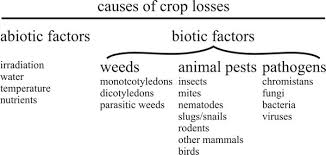
Exercise Yield Loss Implications of Different Microbial Infections
Yield Loss Implications of Different Microbial Infections
We discussed asymptomatic infection above in the context of its genetic control and triggers for symptom development. Whilst symptoms cause obvious loss of green leaf area and thereby reduce yield, asymptomatic infection can be very extensive and must also obtain resources from the host plant and have the potential to cause yield loss. Newton et al. argued that organisms such as those causing the cereal rusts and powdery mildew diseases although commonly referred to as pathogens are in fact parasites as they damage the host their host by draining resources, particularly carbon, rather than actively damaging their host by causing necrosis. In the same way, asymptomatic pathogens occupy this same niche for deriving resources from their host, i.e., the same trophic space, but in their case the relationship can be dynamic. Thus triggers for symptom expression involve necrosis and thus the trophic space occupied becomes that of a pathogen. Yield loss must therefore be calibrated by assessment of microbial load and their relative impact in diverting resources to microbial biomass and/or by reducing green leaf area but the importance of these effects are no yet known.
Some microbes on or in crops can contribute beneficially to yield. Many are root-inhabiting, facilitating acquisition of specific nutrients or water in return for assimilates, mainly carbon. Mycorrhizae are classic examples of these but high soil disturbance conditions coupled with high levels of nutrients tend to mitigate against their presence and efficacy, particularly in crops such as the cereals that are not highly mycorrhizal anyway. However, the response to soils and their microbial communities is seldom a factor in breeding programmes but there is much potential, particularly if fungicidal treatments are more contained, reduced or targeted. This potential has been described as the “evergreen revolution” where the beneficial relationships between crop plants and their symbionts, combined with their influence on soil chemistry, physics and biology, can be exploited as the means to achieving “sustainable intensification”. However, even some fungi normally known as pathogens can have beneficial effects on plant biomass when they fail to transition to the symptomatic or pathogenic trophic state. Classical yield loss relationships to crop genotype and crop protection treatments will be changed in such circumstances and therefore quantification of such endophytic symbiotic colonisations will be important to understand crop yield responses.
Disease-yield loss relationships are clear where disease levels are high. Where they are low they are not only less clear but may also be confounded by plant compensation responses. For example, early damage may result in enhanced tiller production that could even result in enhanced yield, though more but smaller grains could impact quality criteria in some markets.
Determining yield loss or impact of asymptomatic infection in field trials is therefore highly problematic. Treatment with inoculum that results in high levels of pathogen challenge and possibly asymptomatic infection might be one method. This is difficult to achieve in practice but can lead to disruption of the expected relationship between symptom expression and yield loss. Elimination of infection though targeted use of fungicides might be another. However, many fungicides have other effects on the crop, the triazoles and strobilurins for example, cause direct leaf greening, or a leaf greening achieved through shifts in the microbial challenges being experienced by the crop. Using a range of modes of action along with assessment of asymptomatic infection might be a means to factor-out direct effects attributable to differential non-target effects of the fungicides. It should also not be forgotten that fungicides can shift the population structure of bacteria that may affect plant recognition responses.
The disease level at which crop protection treatments should be applied is an area of considerable research and debate. Disease risk curves can be produced for different crops and tailored to specific cultivars showing different economic thresholds. However, the regressions often do not intercept both X (disease) and Y (probability) axes at the origin, more commonly intercepting at a Y value of a positive risk at zero disease, in other words some benefit of crop protection treatment is always found. This could conceivably be above the economic threshold or require only low disease scores to justify treatment. Part of the explanation may be attributable to asymptomatic infection being controlled by such treatments.
Whilst infections can be termed symptomatic or asymptomatic based on the presence or absence of clear visible symptoms, this distinction is, to some extent, a reflection of the ability of the assessor to detect the effects of infection. In reality, even non-destructive infections may have significant effects on important host functions. The commercial consequences of disease (measured by visible symptoms) have been extensively described, but relatively few studies have considered the consequence of asymptomatic infection on crop yield and quality.


